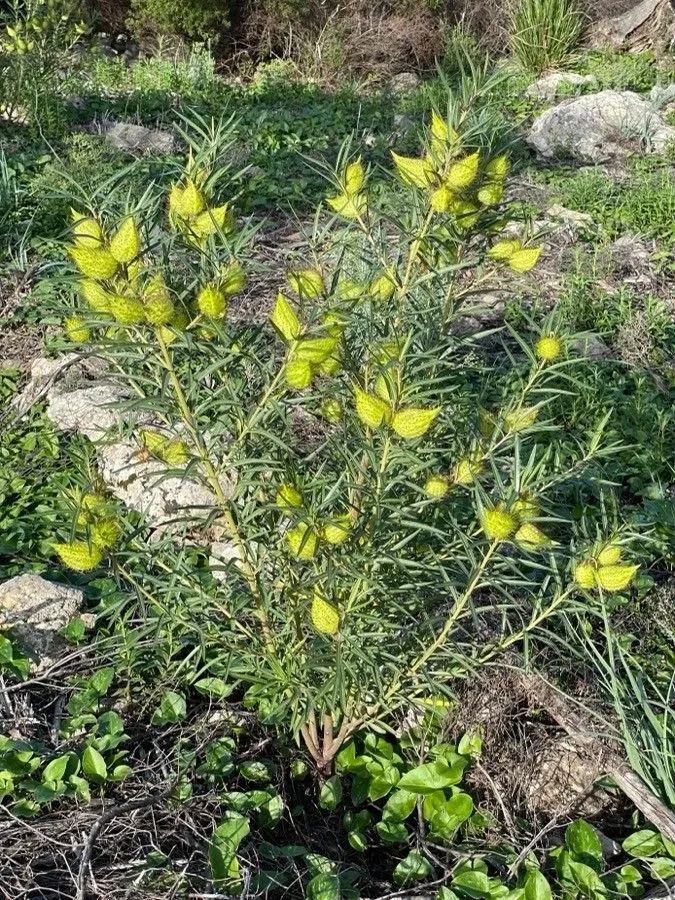
Author: (L.) W.T.Aiton
Bibliography: Hortus Kew. 2: 80 (1811)
Year: 1811
Status: accepted
Rank: species
Genus: Gomphocarpus
Vegetable: False
Observations: Eritrea to S. Africa, Arabian Pen.
Milkweed, scientifically known as Gomphocarpus fruticosus, is a remarkable plant belonging to the family Apocynaceae. It was first described in the early 19th century by the renowned botanist W.T. Aiton, making its initial appearance in the esteemed publication “Hortus Kewensis” in 1811.
This resilient species is native to a wide geographical range that extends from Eritrea in East Africa, down through the southern regions of Africa, and spreading across the Arabian Peninsula. It thrives in a variety of climates and conditions, showcasing its adaptability and robustness.
Milkweed is easily identifiable by its unique and intricate floral structures. The plant produces clusters of small, somewhat spherical flowers that are usually white or cream in color. These flowers are accompanied by slender stems and elongated leaves that provide it with a distinctive, airy appearance.
One of the most fascinating aspects of Gomphocarpus fruticosus is its ecological role. It serves as a crucial host plant for various insect species, particularly for the Monarch butterfly, which relies on milkweed species for laying its eggs and as a primary food source for its larvae. This symbiotic relationship highlights the important role that milkweed plays in supporting biodiversity and maintaining healthy ecosystems.
Additionally, milkweed has been studied for its medicinal properties. The plant contains compounds that have been traditionally used in various cultures to treat a range of ailments. However, it is important to note that parts of the milkweed can be toxic if ingested improperly, necessitating caution and proper knowledge when utilizing it for medicinal purposes.
The versatility and significance of Gomphocarpus fruticosus make it a subject of interest for botanists, ecologists, and gardeners alike. Whether observed in its natural habitat or cultivated in gardens for its aesthetic appeal and ecological benefits, milkweed continues to captivate and contribute to the rich tapestry of the plant kingdom.
Fra: faux cotonnier
Eng: milkweed, narrow-leaf cotton bush, swan plant
Deu: strauch-seidenpflanze
Spa: algodoncillo, arbre de la seda, arquell de síria, cotoner, flor de dragó, mata de la seda, seder, árbol de la seda, árvore-da-seda
Por: falso-algodoeiro, sumaúma-bastarda
En: Milkweed, Narrow-leaf cotton bush, Swan plant
Fr: Faux Cotonnier
De: Strauch-Seidenpflanze
Pt: Falso-algodoeiro, Sumaúma-bastarda
Es: Algodoncillo, Arbre de la seda, Arquell de Síria, Cotoner, Flor de dragó, Mata de la seda, Seder, Árbol de la seda, Árvore-da-seda
Taken Oct 2, 2022 by Corral López José Javier (cc-by-sa)
Taken May 6, 2022 by Monteiro Henrique (cc-by-sa)
Taken Jun 1, 1991 by Daniel Barthelemy (cc-by-nc)
Taken May 6, 2022 by Monteiro Henrique (cc-by-sa)
Taken Jan 15, 2022 by Elvis Tongen (cc-by-sa)
Taken Jan 8, 2022 by germain robo (cc-by-sa)
Taken Nov 25, 2022 by Lala Maier (cc-by-sa)
Taken Jan 25, 2022 by Balbi cañas (cc-by-sa)
Taken Oct 17, 2022 by Rudolf Lottmann (cc-by-sa)
Taken Jan 15, 2022 by Elvis Tongen (cc-by-sa)
Taken Oct 16, 2021 by Di Rame (cc-by-sa)
Taken Nov 5, 2022 by Hugo T (cc-by-sa)
Taken Feb 25, 2022 by Navarro Gustavo (cc-by-sa)
Taken Nov 21, 2021 by Chantal MATTEI (cc-by-sa)
Taken Jan 15, 2022 by Elvis Tongen (cc-by-sa)
Taken Jul 5, 2022 by Monteiro Henrique (cc-by-sa)
Taken Aug 10, 2022 by Maria Taria (cc-by-sa)
Taken Dec 20, 2020 by Mathieu Millan (cc-by-sa)
Taken Oct 26, 2021 by Jellinek Rainer (cc-by-sa)
Taken May 6, 2022 by Monteiro Henrique (cc-by-sa)
Taken Jun 23, 2022 by Monteiro Henrique (cc-by-sa)
Taken Nov 5, 2022 by Hugo T (cc-by-sa)
Taken Aug 17, 2020 by Caccini Stefano (cc-by-sa)
© copyright of the Board of Trustees of the Royal Botanic Gardens, Kew.
© copyright of the Board of Trustees of the Royal Botanic Gardens, Kew.
© copyright of the Board of Trustees of the Royal Botanic Gardens, Kew.
Bloom months: [‘jun’, ‘jul’, ‘aug’]
Family: Myrtaceae Author: (F.Muell.) K.D.Hill & L.A.S.Johnson Bibliography: Telopea 6: 402 (1995) Year: 1995 Status:…
Family: Rubiaceae Author: Pierre ex A.Froehner Bibliography: Notizbl. Bot. Gart. Berlin-Dahlem 1: 237 (1897) Year:…
Family: Sapindaceae Author: Koidz. Bibliography: J. Coll. Sci. Imp. Univ. Tokyo 32(1): 38 (1911) Year:…
Family: Asteraceae Author: A.Gray Bibliography: Pacif. Railr. Rep.: 107 (1857) Year: 1857 Status: accepted Rank:…
Family: Fabaceae Author: Medik. Bibliography: Vorles. Churpfälz. Phys.-Ökon. Ges. 2: 398 (1787) Year: 1787 Status:…
Family: Aspleniaceae Author: (Cav.) Alston Bibliography: Bull. Misc. Inform. Kew 1932: 309 (1932) Year: 1932…